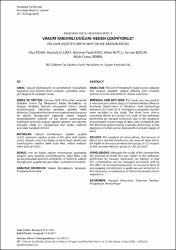VAKUM YARDIMLI DOĞUM: NEDEN ÇEKİNİYORUZ?
Özet
AMAÇ: Vakum ekstraksiyon ile gerçekleşen müdahaleli doğumun kısa dönem klinik sonuçları açısından, sezaryen doğum ile karşılaştırılması. GEREÇ VE YÖNTEM: Çalışma 2015-2016 yılları arasında Gülhane Askeri Tıp Akademisi Kadın Hastalıkları ve Doğum Anabilim Dalında retrospektif kohort olarak yürütülmüştür. Çalışmaya primipar gebeler dahil edilmiştir. Doğumun ikinci evresinin uzaması endikasyonu ile vakum ekstraksiyon yapılarak vajinal doğum gerçekleştirilen gebeler ile baş pelvis uyumsuzluğu nedeniyle sezaryen doğum yapılan gebeler kısa dönem sonuçları (fetal pH, postpartum kan kaybı, maliyet) açısından karşılaştırılmıştır. BULGULAR: Vakum ekstraksiyon yapılan grupta (n:22), sezaryen yapılan gruba (n:30) göre aktif eylem süresi, doğum sonu kan kaybı ve buna bağlı olarak kan transfüzyonu oranları daha fazla iken, tedavi maliyeti daha azdır (p<0,05). SONUÇ: Her ne kadar vakum ekstraksiyon grubunda doğum sonu kanama komplikasyonu daha fazla olsa da, bu konudaki deneyim arttırılmalı ve hekimler vakum ekstraksiyon uygulaması açısından cesaretlendirilmelidir. OBJECTIVE: The aim of the present study was to compare the vacuum assisted- vaginal delivery and cesarean section in terms of short term clinical outcomes. MATERIAL AND METHODS: The study was executed as a retrospective cohort study at Gülhane Military Medical Academy Department of Obstetrics and Gynecology between 2015 and 2016. Primiparous pregnant women were included in the study. The short term clinical outcomes (feotal pH, blood loss, cost) of the deliveries performed by vacuum extraction due to the diagnosis of prolonged second stage of labor were compared with the deliveries performed by cesarean section due to the diagnosis of cefalo-pelvic disproportion at early stages of labor. RESULTS: The duration of active phase, the amount of blood loss and the transfusion rate were all detected to be higher in the vacuum extraction group (n=22) respect to the cesarean delivery group (n=30). (p<0,05) CONCLUSIONS: Although the results of this showed that the amount of blood loss was higher in the deliveries performed by vacuum extraction, we believe in that this complication can be managed exclusively well by the effect of increased experience. So we are in favor of encouraging obstetricians to apply vacuum extraction in the necessary circumstances to obtain increased clinical experience.
















